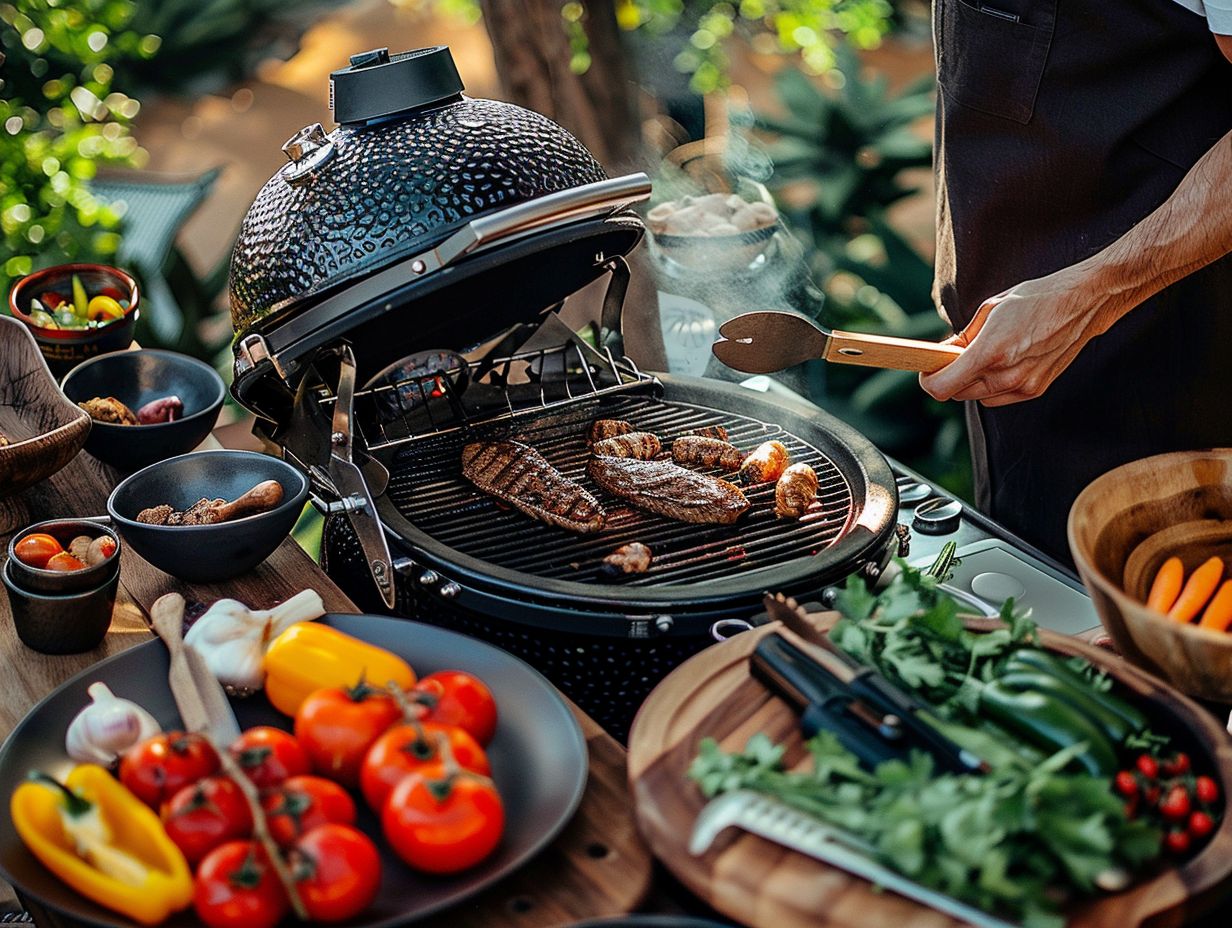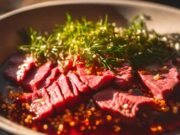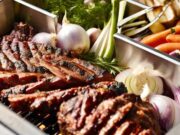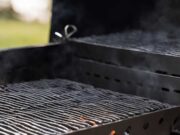- Key Takeaways:
- Mastering the Art of Kamado Grilling: Tips and Techniques for Beginners
- Understanding Your Kamado Grill
- Setting Up Your Kamado Grill
- Mastering Temperature Control
- Essential Kamado Grilling Tips
- Flavoring Techniques
- Maintenance and Care
- Encouragement to Start Your Kamado Grilling Journey
- Frequently Asked Questions
If you are new to grilling and seek to enhance your outdoor cooking experience, mastering the art of kamado grilling is an excellent choice.
This versatile and efficient method provides unique flavors and cooking styles that can impress any barbecue enthusiast. You will discover the ins and outs of kamado grills, including how to set them up, control temperatures, and explore various flavor-enhancing techniques.
With essential tips and maintenance advice, you will be well-equipped to embark on your kamado grilling journey and create mouthwatering dishes.
Key Takeaways:

- Understand the benefits of using a Kamado grill, such as its versatility and ability to retain heat, for a successful grilling experience as a beginner.
- Master temperature control by using techniques such as adjusting airflow and choosing the right type of charcoal, to achieve the perfect temperature for your desired cooking method.
- Enhance your grilling experience with flavoring techniques such as using wood chips and marinades, and maintain your Kamado grill for longevity by following proper cleaning and care tips.
Mastering the Art of Kamado Grilling: Tips and Techniques for Beginners
Kamado grilling is an ancient technique that employs a ceramic kamado grill to deliver exceptional results in backyard cooking. This method allows you to delve into the art of grilling, smoking, and baking a variety of delicious foods, including brisket, steaks, ribs, and even pizzas.
The versatility of this cooking technique, highlighted by its distinct shape and excellent heat retention properties, enables you to master temperature control through the use of charcoal, heat deflectors, and effective airflow management. As a result, it is an ideal choice for both novice and experienced grillers.
Understanding Your Kamado Grill
To fully embrace the art of kamado grilling, it is essential for you to understand the unique features and functionalities of your kamado grill, which is primarily constructed from high-quality ceramic materials that offer excellent heat retention and distribution.
This understanding enables you to optimize the grill’s capabilities by effectively controlling temperature and airflow, ensuring that you achieve the desired results whether you are grilling, baking, or smoking your favorite meats.
What is a Kamado Grill?
A kamado grill is a traditional Japanese cooking appliance known for its distinctive egg-like shape and primarily constructed from ceramic materials. This design offers exceptional heat retention, making it suitable for various cooking techniques, including grilling, baking, and smoking.
Rooted in ancient Asian culture, particularly in Japan, these versatile cooking devices have evolved significantly over time, blending traditional craftsmanship with modern innovation. The grill’s design features thick ceramic walls that provide excellent insulation, ensuring consistent temperatures throughout the cooking process.
As a user, you will appreciate the kamado grill’s ability to serve multiple purposes, from searing meats at high heat to slow-cooking or baking pizzas, which expands your outdoor culinary possibilities. Its efficient use of charcoal as a fuel source not only enhances flavor but also reduces overall cooking costs, making it a valuable tool for both amateur and professional chefs alike.
Benefits of Using a Kamado Grill for Beginners
For beginners, utilizing a kamado grill offers numerous advantages, including its ability to deliver exceptional flavor through charcoal, temperature versatility, and various cooking methods that accommodate everything from slow smoking to high-temperature grilling.
This unique grill not only enhances the taste of meats and vegetables but also streamlines the grilling process, making it an ideal choice for individuals embarking on their culinary journey. With its well-insulated design, a kamado grill retains heat exceptionally well, allowing for precise temperature control that suits all types of grilling, baking, or roasting.
The straightforward setup and operation enable novices to quickly learn how to use the grill effectively without feeling overwhelmed. The versatility of this grill encourages experimentation with different recipes and flavors, fostering confidence and creativity in any aspiring chef.
Setting Up Your Kamado Grill
Setting up your kamado grill correctly is essential for achieving optimal performance and flavor in your cooking. This process involves the proper placement of key components, such as the heat deflector and fire grate, as well as selecting the appropriate type of charcoal to suit your desired grilling experience.
Essential Accessories for Kamado Grilling
Essential accessories for kamado grilling include items that enhance functionality and cooking versatility. Consider incorporating heat deflectors for indirect cooking, fire grates for optimal charcoal placement, and various grilling tools that assist in achieving the perfect temperature.
These accessories not only elevate your grilling experience but also ensure that your food is cooked evenly and with maximum flavor. For example, a quality pizza stone can transform your kamado into an authentic outdoor pizza oven, allowing you to create perfectly crisp crusts. Additionally, flavor-infusing wood chips and chunks can impart rich smoked flavors to meats and vegetables, enhancing the overall taste profile of your dishes.
Thermometers are equally crucial, as they allow for precise monitoring of internal temperatures, helping you prevent overcooking. By incorporating these tools into your grilling routine, you can truly unlock the potential of your kamado, making it a versatile centerpiece for outdoor cooking.
Preparing Your Kamado Grill for First Use

Preparing your kamado grill for its inaugural use involves following specific steps to ensure optimal performance, including cleaning the grill, seasoning the ceramic, and properly loading it with charcoal to establish the desired cooking temperature.
To begin, gather all necessary tools, such as a cleaning brush, mild soap, and high-quality charcoal. Start by thoroughly cleaning the grill’s interior with a mild soap solution to eliminate any manufacturing residues that could impact flavor. Once the grill is spotless, it is essential to season the ceramic by lighting a small fire and gradually heating it. This process strengthens the structure and prepares it for high-heat cooking.
When adding charcoal, fill the firebox to the appropriate level while leaving space for airflow, as achieving the correct temperature is crucial for successful grilling. Ensure the vents are adjusted properly for optimal air circulation, which will aid in effectively controlling the heat.
Mastering Temperature Control
Mastering temperature control in your kamado grill is essential for achieving optimal results. It requires a thorough understanding of how to manipulate airflow and manage charcoal effectively to maintain consistent heat levels for different cooking methods, including grilling, baking, and smoking.
Techniques for Achieving the Perfect Temperature
Achieving the perfect temperature on your kamado grill requires specific techniques, including adjusting the air vents to regulate airflow, selecting the appropriate type of charcoal, and using a reliable thermometer for accurate monitoring of cooking conditions.
Airflow management is crucial for maintaining consistent heat, as it directly influences the grill’s ability to reach and sustain desired temperatures. Proper positioning of the top and bottom vents facilitates optimal oxygen flow, allowing the charcoal to burn efficiently. Selecting the right charcoal can significantly affect heat retention; for instance, lump charcoal typically produces cleaner burns and higher heat, while briquettes provide a steadier, more consistent temperature.
Experienced grillers emphasize the importance of using a high-quality thermometer, as precise readings can help you avoid overheating or undercooking, ensuring perfectly grilled meals every time.
Understanding the Airflow System in Kamado Grills
Understanding the airflow system in kamado grills is essential for controlling temperature. It allows you to regulate the oxygen flow to the charcoal, which directly impacts cooking efficiency and the overall flavor of your food.
This system consists of both intake and exhaust dampers that work together to create a balance, influencing heat distribution within the grill. When you open the intake damper, more oxygen fuels the charcoal, raising the temperature; conversely, closing it reduces airflow, resulting in a calmer cooking environment.
This effortless control over airflow enables you to achieve low-and-slow smoking or high-temperature searing, accommodating various culinary techniques. Mastering this intricate mechanism not only enhances your grilling experience but also significantly affects the taste and texture of your finished dishes.
Essential Kamado Grilling Tips
To enhance your kamado grilling experience, it is essential for you to master key grilling tips. This includes understanding the various types of charcoal suitable for your grill, selecting the appropriate cooking methods, and employing effective techniques to achieve optimal flavor and texture in your dishes.
Best Types of Charcoal for Kamado Grilling
When engaging in kamado grilling, selecting the appropriate type of charcoal is crucial. Lump charcoal is often preferred for its ability to burn hotter and longer, while briquettes provide a more consistent heat source, making them suitable for extended cooking sessions.
This choice significantly impacts your overall grilling experience, as each type contributes unique characteristics to the cooking process. Lump charcoal, derived from charred hardwood, ignites quickly and reaches high temperatures, which are perfect for searing meats and achieving those desirable grill marks. In contrast, briquettes are made from compressed sawdust and include additives that ensure a steady burn, making them ideal for low-and-slow cooking techniques, such as smoking.
Understanding how each type of charcoal interacts with the heat retention and airflow of a kamado grill can give the power to you to enhance flavor and achieve your desired cooking results, underscoring the vital role of charcoal in mastering barbecue techniques.
Cooking Methods: Direct vs. Indirect Heat
Understanding the difference between direct and indirect heat is essential for effective kamado grilling. Direct heat is ideal for searing steaks and ribs, while indirect heat offers a slower cooking method, making it suitable for baking or smoke-infusing larger cuts of meat.
To set up the kamado grill for direct heat, arrange the charcoal in a mound configuration. This allows for maximum airflow, helping you achieve high temperatures, typically around 500°F. This setup is perfect for quickly cooking foods that benefit from a nice char.
For indirect heat, place a heat deflector or ceramic plate between the charcoal and the food. This creates a barrier that enables slower, more even cooking at temperatures ranging from 225°F to 325°F. This method works exceptionally well for roasting whole chickens or ribs, allowing for a deeper flavor infusion without burning the exterior.
Flavoring Techniques

Enhancing the flavor of dishes cooked on a kamado grill can be accomplished through a variety of flavoring techniques. Utilizing wood chips for smoking, along with applying marinades and rubs to meats before cooking, can significantly deepen the overall taste profile of your meals.
Using Wood Chips and Chunks for Extra Flavor
Utilizing wood chips and chunks in your kamado grill can impart unique flavors to your food, as different types of wood—such as hickory, mesquite, or apple—each contribute distinct aromas and tastes during the smoking process.
For example, hickory is renowned for its robust and smoky flavor, which pairs exceptionally well with red meats. Conversely, mesquite offers a stronger, earthy taste that enhances the richness of steak or chicken. In contrast, fruitwoods like apple and cherry provide a sweeter, milder smoke, making them ideal for poultry and pork.
When employing these wood varieties in your kamado grill, it is essential to soak the chips in water for at least 30 minutes before adding them to the fire. This ensures a slow and steady release of smoke, maximizing flavor absorption throughout the cooking process.
Marinades and Rubs: Enhancing Your Grilling Experience
Applying marinades and rubs to your meats before grilling on a kamado grill enhances flavor while also tenderizing the meat. This technique allows for a more succulent final dish that truly showcases the grill’s capabilities.
By infusing rich and diverse flavors, these methods can transform even the simplest cuts of meat into gourmet delights. For example, a classic garlic and herb marinade can add a burst of freshness to chicken, while a sweet and tangy barbecue rub creates a perfect caramelized crust on ribs.
To apply these techniques effectively, it is essential to allow sufficient time for the flavors to penetrate; marinating for several hours or even overnight is often recommended. Likewise, dry rubs should be massaged directly into the meat to ensure even coverage. The outcome not only intensifies the taste but also contributes to a beautifully charred exterior that is visually appealing and delicious.
Maintenance and Care
Proper maintenance and care for your kamado grill are essential to ensure its longevity and optimal performance. This involves regular cleaning, inspecting ceramic components, and storing the grill appropriately when not in use to protect it from the elements.
Cleaning Your Kamado Grill After Use
Cleaning your kamado grill after each use is essential for maintaining its performance and flavor integrity. This process involves removing ash, cleaning the ceramic surfaces, and checking for any food particles that may have accumulated during cooking.
Regular maintenance ensures that the grill operates efficiently and enhances the taste of your meals. To begin the cleaning process, allow the grill to cool down completely to minimize the risk of burns.
Start by removing the grates and any other removable components to access the interior. Use an ash tool to scoop out the ash from the bottom of the grill, ensuring it is discarded properly.
Next, take a soft brush or cloth and gently wipe down the ceramic surfaces, avoiding harsh chemicals that could damage the glaze. It is also important to inspect the seals and gaskets for any signs of wear, as keeping these components in good condition aids in heat retention during cooking.
Long-term Care Tips for Longevity
Ensuring the longevity of your kamado grill requires regular cleaning as well as the implementation of long-term care practices. Cover the grill when not in use, avoid extreme temperature changes, and schedule periodic inspections of its components to maintain its condition.
Investing in high-quality accessories, such as heat deflectors and cooking stones, is crucial as they can enhance your grilling experience while also protecting the internal surfaces of the grill. Regularly check the gasket for wear and ensure proper sealing, as this will contribute to efficient heat retention—a key factor in achieving the perfect cook.
Additionally, using a grill guard can shield the grill from the elements, and seasoning the grill’s surface helps maintain its resilience against rust and corrosion.
Taking these proactive measures is essential for anyone looking to maximize the performance and lifespan of their kamado grill.
Encouragement to Start Your Kamado Grilling Journey
If you are prepared to embark on your kamado grilling journey, it is time to explore the extensive range of cooking possibilities that this unique grill offers, from smoking brisket to baking pizzas, all while impressing your friends and family with your developing grilling skills.
As you immerse yourself in this dynamic cooking style, you will uncover the art of temperature control and the satisfaction of experimenting with various flavors and techniques. Picture yourself savoring mouthwatering ribs after a slow cook or enjoying a perfectly crafted margherita pizza, all while receiving admiration from your loved ones.
The versatility of kamado grills enables you to expand your culinary repertoire, transforming grilling from a mere task into an engaging experience. With each meal, you will build confidence and skill, turning outdoor cooking into a delightful social event that everyone can partake in.
So, gather your friends, ignite that kamado, and embark on a series of delicious culinary adventures.
Frequently Asked Questions

What is a kamado grill?
A kamado grill is a traditional Japanese-style ceramic grill that is designed for high-heat, low-oxygen cooking. It can be used for grilling, smoking, and baking, making it a versatile tool for outdoor cooking.
Why should I choose a kamado grill over other types of grills?
Kamado grills offer excellent heat retention and precise temperature control, making them ideal for cooking a wide variety of foods. They also use less charcoal than other grills and produce very little ash, making them more efficient and easier to clean.
What are some beginner tips for using a kamado grill?
First, make sure to read the instructions and familiarize yourself with your grill. Start with simple recipes and practice controlling the temperature. Use lump charcoal instead of briquettes for better flavor. And always use heat-resistant gloves and tools when handling hot surfaces.
What are some common mistakes beginners make when using a kamado grill?
One common mistake is not allowing enough time for the grill to preheat, resulting in uneven cooking. Another is using too much charcoal, which can lead to excessively high temperatures. It’s also important to make sure the grill is properly sealed to prevent air leaks.
What are some recommended foods to try on a kamado grill?
Kamado grills are great for cooking a wide variety of foods, including meats, seafood, vegetables, and even pizza. Some popular recipes to try include smoked brisket, grilled salmon, and roasted vegetables.
Are there any safety precautions I should take when using a kamado grill?
Yes, always use caution when handling hot surfaces and keep children and pets away from the grill. Make sure to properly clean and maintain your grill to prevent any accidents. It’s also important to follow food safety guidelines when cooking on a kamado grill.



















































